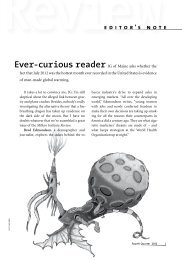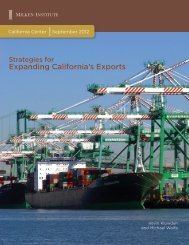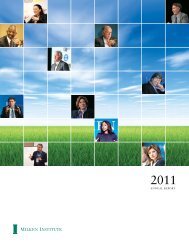The Rise and Fall of the U.S. Mortgage and Credit ... - Milken Institute
The Rise and Fall of the U.S. Mortgage and Credit ... - Milken Institute
The Rise and Fall of the U.S. Mortgage and Credit ... - Milken Institute
You also want an ePaper? Increase the reach of your titles
YUMPU automatically turns print PDFs into web optimized ePapers that Google loves.
<strong>The</strong>re has been a dramatic decline in <strong>the</strong> capital-asset ratio <strong>and</strong> <strong>the</strong> long-term increase in <strong>the</strong> leverage <strong>of</strong><br />
commercial banks. Indeed, each dollar <strong>of</strong> capital supported $3.56 <strong>of</strong> assets in 1896, whereas <strong>the</strong> same dollar<br />
supported $9.89 <strong>of</strong> assets in 2007. <strong>The</strong> leverage issue for financial firms is compounded by <strong>the</strong> fact that <strong>the</strong>y also<br />
rely on borrowings to fund <strong>the</strong>ir assets. In 1994, borrowed funds were 14 percent <strong>of</strong> total assets, but <strong>the</strong>y had<br />
increased to 20 percent by <strong>the</strong> second quarter <strong>of</strong> 2008. Heavier reliance on borrowed funds means that banks<br />
must be able to roll over those funds to maintain <strong>the</strong> same total amount <strong>of</strong> assets, apart from any increases in<br />
equity. This puts banks in a more difficult position when asset values decline <strong>and</strong> <strong>the</strong> investors from whom <strong>the</strong>y<br />
borrow become increasingly reluctant to lend. In such a situation, banks are required to raise additional capital,<br />
sell assets, or undertake a combination <strong>of</strong> <strong>the</strong> two, even just to be sure <strong>the</strong>re is sufficient cash to meet payrolls<br />
<strong>and</strong> o<strong>the</strong>r ongoing operating expenses.<br />
…with Fannie Mae <strong>and</strong> Freddie Mac?<br />
<strong>The</strong>se two government-sponsored enterprises (or GSEs) became <strong>the</strong> dominant players in <strong>the</strong> home mortgage<br />
market, holding or guaranteeing more than $5.5 trillion in home mortgages. But both Fannie Mae <strong>and</strong> Freddie<br />
Mac were enormously highly leveraged. With thin capital ratios, any significant decline in <strong>the</strong> value <strong>of</strong> <strong>the</strong>ir<br />
assets would wipe out <strong>the</strong>ir capital—<strong>and</strong> both institutions did indeed suffer substantial losses when housing<br />
prices began to decline. On a fair value basis, Fannie Mae reported it was near insolvency in <strong>the</strong> second quarter<br />
<strong>of</strong> 2008, while Freddie Mac reported it was actually insolvent. One quarter later, however, both institutions were<br />
reporting insolvency on a fair value basis.<br />
This dire situation can largely be explained by <strong>the</strong> fact that both<br />
institutions have had a m<strong>and</strong>ate not simply to focus on pr<strong>of</strong>its, but<br />
to provide funding for affordable housing. Also, both institutions<br />
recently were holding relatively large amounts <strong>of</strong> securities backed<br />
by subprime <strong>and</strong> Alt-A mortgages (Alt-A loans are a notch above<br />
subprime, but considered riskier than prime loans). <strong>The</strong> subprimebacked<br />
securities alone accounted for 71 percent <strong>of</strong> <strong>the</strong> core capital<br />
<strong>of</strong> Fannie Mae, <strong>and</strong> 116 percent <strong>of</strong> <strong>the</strong> core capital <strong>of</strong> Freddie Mac.<br />
Fur<strong>the</strong>rmore, interest-only conventional mortgages securitized by<br />
Freddie Mac increased from $25 billion in 2005 to $159 billion, or<br />
more than 500 percent, in 2007.<br />
19<br />
� Going forward, much<br />
more effort should be<br />
devoted to preemptive<br />
actions that can prevent<br />
asset bubbles ra<strong>the</strong>r<br />
than to cleaning up<br />
<strong>the</strong> mess once <strong>the</strong><br />
bubbles have burst.















